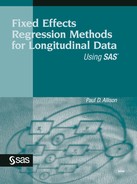3.8. Summary
In this chapter we've seen how the fixed effects methods developed for continuous response variables in chapter 2 can be extended to categorical response variables. Most of the chapter focused on regression models for dichotomous responses. When there are just two dichotomous observations for each individual, a fixed effects regression model can be estimated by (a) discarding all cases that have the same values on the two response variables, (b) recoding all time-varying explanatory variables as difference scores, and (c) fitting a conventional logistic regression model to one of the response variables. This is a form of conditional maximum likelihood.
We then considered the more general case where individuals may have more than two dichotomous response observations. As in chapter 2, the first step is to reorganize the data so that there is a separate record for each response for each individual. But unlike the linear models in chapter 2, it is not legitimate to estimate a conventional logistic regression model with dummy variables for the individuals. Because of the incidental parameters problem, the coefficients from such a regression will be upwardly biased. Instead, we use conditional maximum likelihood to "condition out" the fixed effects. In SAS, this is accomplished with the STRATA statement in PROC LOGISTIC.
Possible alternatives to fixed effects logistic regression are GEE estimation of logistic regression models with PROC GENMOD and random effects logistic regression models estimated with PROC NLMIXED. Unlike the fixed effects approach, neither of these methods controls for unmeasured, time-invariant explanatory variables. Among these two methods, PROC NLMIXED has the advantage of producing subject-specific rather than population-averaged coefficients. Population-averaged coefficients are generally attenuated toward zero by unobserved heterogeneity. We then combined the fixed effects and random effects approaches into a hybrid model by decomposing time-varying covariates into individual mean values and deviations from those means. This can be accomplished with either PROC GENMOD or PROC NLMIXED.
Finally, we considered how these approaches might be extended to response variables with more than two categories. Although conditional maximum likelihood could, in principle, be applied to unordered, multinomial response models, there is currently no SAS procedure that will accomplish this in general cases. For ordered multinomial responses, a hybrid cumulative logit model can be estimated with GENMOD or NLMIXED. For unordered multinomial responses, a hybrid generalized logit model can be estimated with PROC SURVEYLOGISTIC.
